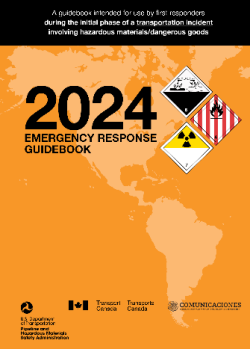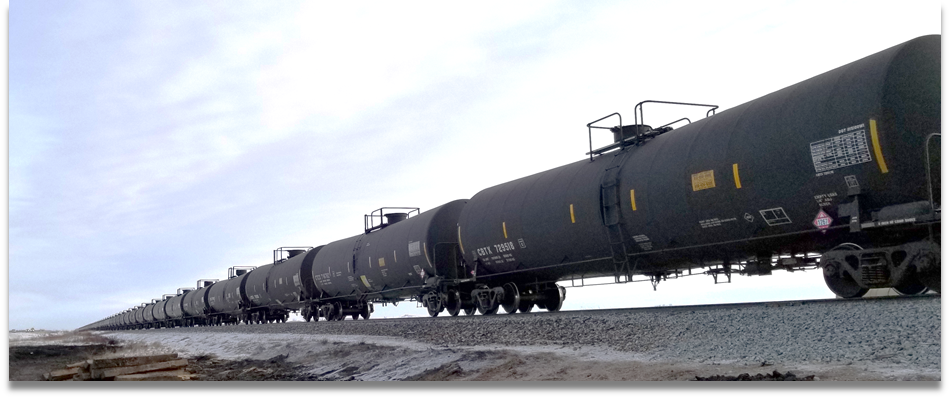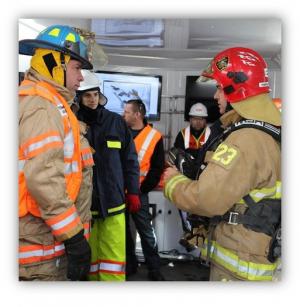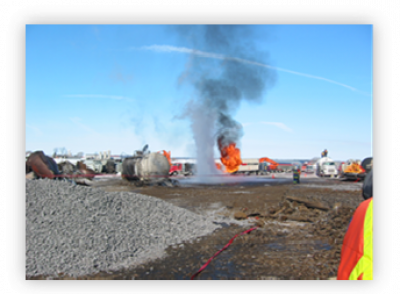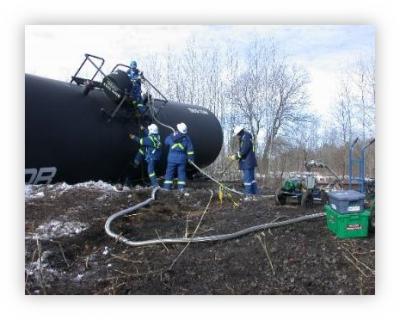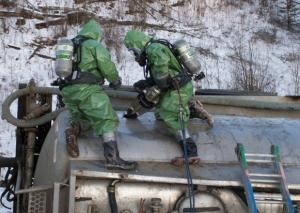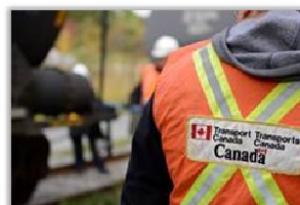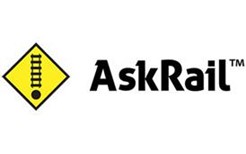On this page
- Reporting a dangerous goods incident
- Emergency Response Guidebook (ERG)
- CANUTEC
- Shipping document
- Emergency Response Assistance Plan (ERAP)
- Remedial Measures Specialist (RMS)
- Incident Management System
- Protective Direction (PD) 36
- Additional resource: AskRail
- Best practices
- Contacts
- Related links
Reporting a dangerous goods DG incident
When a DG incident occurs, the person who has possession of the DG at the time of the incident should call (if applicableFootnote 1):
- the appropriate authority (9-1-1)
- CANUTEC at *666 on a mobile phone, 613-996-6666 or 1-888-CANUTEC
- the 24-hour number found on the shipping document
- the ERAP telephone number found on the shipping document
Emergency Response Guidebook (ERG)
When First Responders arrive at the site of a DG incident, they should refer to the ERG to determine safe distances and secure the scene.
The ERG is developed by TC (CANUTEC), the United States, Mexico and Argentina. The guide will also provide First Responders with:
- quick identification of the hazards of the materials involved in the DG incident
- information on how to protect themselves and the general public
For more information on the ERG: 2024 Emergency Response Guidebook
CANUTEC
When First Responders arrive at the site of a DG incident, they should also contact CANUTEC for assistance.
- CANUTEC is the Canadian Transport Emergency Centre, a branch of the TDG Directorate
- Bilingual scientists work at CANUTEC on a 24/7 basis, are trained in emergency response and are ready to assist during a DG incident
- CANUTEC’s role is to provide advice during a DG incident but also to bring together all the players involved in the DG incident
CANUTEC is the TDG emergency call center providing technical advice to first responders at an incident, 24/7.
- Chemical, physical and toxicological properties of DG
- Immediate public safety actions
- Isolation and evacuation distances
- Potential health effects
- Protective clothing requirements and decontamination
- Instability and incompatibility of products
- Mitigation techniques for DG
- Basic plume / dispersion modeling analysis
Shipping document
In addition to observations of the scene from a safe distance, the shipping document is an important piece of information, if it can be safely retrieved. It may be in the form of a paper or an electronic copy and it will include the following information:
- the shipping name (and nature) of the DG
- the amount of DGs being transported
- the 24-hour telephone number for technical information about the DG
- the ERAP telephone number (if applicable) for technical and/or emergency response advice
More information on shipping documents can be found in Part 3 (Documentation) of the TDG Regulations and in the TDG Bulletin on shipping document.
Emergency Response Assistance Plan (ERAP)
What is an ERAP?
- For the transportation of certain higher-risk dangerous goods, the Transportation of Dangerous Goods Act, 1992 (TDG Act) requires an ERAP to be in place
- An ERAP describes what to do in the case of a release or anticipated release of certain higher-risk dangerous goods while they are in transport
- ERAPs list specialized personnel and equipment needed for responding to an incident, as well as give examples of response actions these resources will be used for
Who requires an ERAP?
- Persons who have ERAPs are involved in the transportation (shipping, receiving or transporting) of certain DG above the quantity specified in the TDG Regulations
- They are often producers, manufacturers or distributors of DG
Purpose of an ERAP
- A person with an approved ERAP uses the plan to assist emergency responders
- ERAPs may be used along with emergency response plans from other organizations (for example, carriers and local or provincial authorities)
- An incident management system ensures coordination between the ERAP and other emergency response plans, in order to:
- ensure public safety
- ensure public safety
- minimize consequences
Components of an ERAP
- ERAPs are approved by TC following the conditions indicated in Part 7 of the TDG Regulations
- Each plan is specific to certain:
- dangerous goods
- modes of transport (air, rail, road, marine)
- means of containment (containers or packaging)
- geographical area in which the dangerous goods will be transported
- Only certain dangerous goods in specified quantities, means of containment or modes of transport need an ERAP
When are ERAPs implemented?
- ERAPs are implemented to respond to a release or anticipated release of the DG that are part of the plan
- Often, the person who has the ERAP is contacted through the ERAP telephone number. Once reached, this person determines the actions they will take to respond to the release or anticipated release
What is an ERAP telephone number?
- Every ERAP must have an ERAP telephone number
- When a consignment requires an ERAP, this number is found on the shipping document
- Persons calling the ERAP telephone number will be connected with someone who can implement the plan. That person will:
- provide technical and/or emergency response advice promptly
- monitor the response
- send ERAP emergency response resources, if required
Who can implement an ERAP?
- Anyone can call the ERAP telephone number for assistance
- Only the persons who have the ERAP are responsible for implementing it. Any other person or organization cannot implement an ERAP.
- When necessary to protect public safety, section 7.1 of the TDG Act allows TC to:
- direct a person with an approved ERAP to implement their plan in order to respond to a release or anticipated release
- authorize a person with an approved ERAP to implement their plan, if it is unclear who is required to have an ERAP for the DG involved in an incident
ERAPs: What can you expect?
| Assistance for dangerous goods with an approved ERAP | |
|---|---|
| Over the phone |
|
| On site* |
|
| *When an ERAP is implemented, persons having the ERAP are required to exercise due diligence and respond within a reasonable time frame, given the site location, weather conditions, accessibility or other circumstances. | |
Remedial Measures Specialist (RMS)
- A scientist trained and specialized in emergency response
- An ERAP specialist
- A designated TDG Act Inspector under the TDG Act
Role of the RMS, ERAP Specialist:
- Review ERAP applications and evaluate if the plan can be implemented and will be effective at responding to an actual or anticipated release of DG that endangers or could endanger public safety
- Conduct oversight activities such as site assessments and exercise attendance to confirm the response capabilities identified in the ERAP
- Promote awareness of the ERAP program by participating in and presenting at various events across the country
| Role of the RMS at a dangerous goods incident site |
|---|
|
|
|
|
|
Incident Management System
An efficient Incident Management System is a standardized on-site management system that integrates a combination of:
- facilities
- equipment
- personnel
- procedures
- communications
And operates within a common organizational structure.
Incident Commander
The Incident Commander is the person in charge at the incident site and is appointed by the Authority Having Jurisdiction (AHJ).
The Incident Commander is responsible for:
- establishing command
- ensuring responder safety
- assessing incident priorities
- determining operational objectives
- developing and implementing an incident action plan
- developing an organizational structure
- managing incident resources
- coordinating the activities of outside agencies
As incidents can involve many different participating agencies, having an Incident Management System in place will help first responders to deliver a coordinated response to complex and/or large scale incidents by:
- clearly understanding respective roles and responsibilities
- operating in a unified command structure
- recognizing one incident commander assigned by the AHJ
- building trust and networking ahead of crisis with planning and targeted exercises
- prioritizing public safety over enforcement operations until such time as public safety is secure
Protective Direction (PD) 36
A Protective Direction is issued under Section 32 of the TDG Act to cease an activity or to conduct other activities to reduce any danger to public safety.
PD 36
- Directs any company who transports DG through a jurisdiction (municipality) by rail, to provide the municipality’s Emergency Planning Official (EPO) with information on the nature and volume of DG it transports through the municipality
- Directs Canadian Class 1 Rail Carriers to publish an annual report containing DG information on their website
- Requires railway companies to provide in writing to CANUTEC, contact information of the person who will liaise with a municipality’s EPO
Benefits for municipalities
- Raise awareness on the DG being transported by rail within their boundaries
- Helps municipalities plan and prepare their emergency response plan (ERP) accordingly
TC strongly encourages municipalities’ EPOs to register with CANUTEC in order to receive information on the nature and volume of DG being transported by rail through their municipality.
Additional resource: AskRailTM
The AskRailTM app is a safety tool that gives first responders immediate access to accurate, timely data about railcar contents so they can make informed decisions in the event of a rail emergency.
- Use a simple railcar ID search to see whether a railcar on a train is carrying DG
- View the contents of the entire train
- View emergency contact information for all Class I railroads (CN Rail & CP Rail) and
available shortlines
Key points:
- All North American Class I railroads are using the app
- The AskRailTM app is a collaborative effort among all North American Class I railroads, the Association of American Railroads, Railinc Corp. and the Transportation Technology Center, Inc.
- At this time, the app concentrates on single-car information on participating regional railroads
- AskRailTM is available in English and French in the U.S., Canada and Mexico
Request the application
For security reasons, only qualified emergency responders who have completed rail emergency training sponsored by one of the Class I freight railroads or at the Security and Emergency Response Training Center (SERTC) can download and use the AskRailTM app. In addition, railroads can offer the app to known emergency responders along their routes.
Visit their website: AskRailTM or Rail Association of Canada (RAC)
Best practices
To better prepare for DG incidents, municipalities should:
- review their Emergency Response Plan (ERP) template to include response to DG incidents
- take advantage of PD 36 during the planning of their ERP to receive information on DGs transported by rail
- identify industries and DGs transiting their cities
- identify the equipment required by First Responders when responding to an incident
- test their ERP by organizing training and exercises, including participants from other organizations to evaluate interoperability
- register for the online TDG Newsletter for valuable information on the transportation of dangerous goods
In Canada, there are about 30 million dangerous goods shipments every year, 99.998% reaching their destination without incident.
Contacts
For regulatory questions, contact the TDG regional office in your region:
Atlantic
1-866-814-1477
TDG-TMDAtlantic@tc.gc.ca
Prairie & Northern
1-888-463-0521
pnrtdg-tmdrpn@tc.gc.ca
Quebec
1-514-633-3400
TMD-TDG.Quebec@tc.gc.ca
Pacific
1-604-666-2955
TDGPacific-TMDPacifique@tc.gc.ca
Ontario
1-416-973-1868
TDG-TMDOntario@tc.gc.ca
National Capital Region
tdg-tmd@tc.gc.ca
TDG Directorate Contacts
General TDG information: TDG-TMD@tc.gc.ca
Response Operations Team ( ERAP Program):
TC.ChiefResponseOperations-ChefOperationsDeReponse.TC@tc.gc.ca
Safety Awareness Team:
TC.TDGSafetyAwareness-SensibilisationalasecuriteduTMD.TC@tc.gc.ca
For emergencies (24 hours a day, 7 days a week) dial:
- 1 888 CANUTEC
- (613) 996-6666
- *666 on a mobile phone (in Canada only)
Website: CANUTEC
